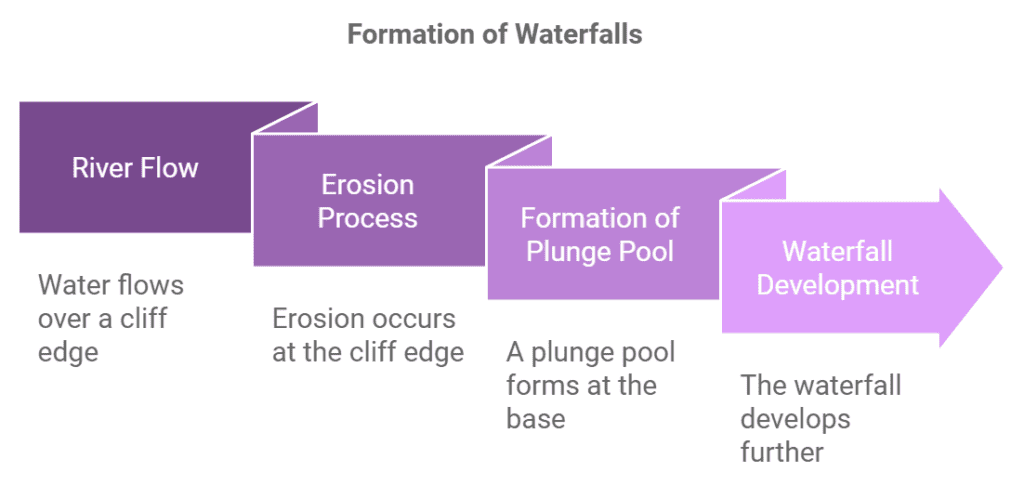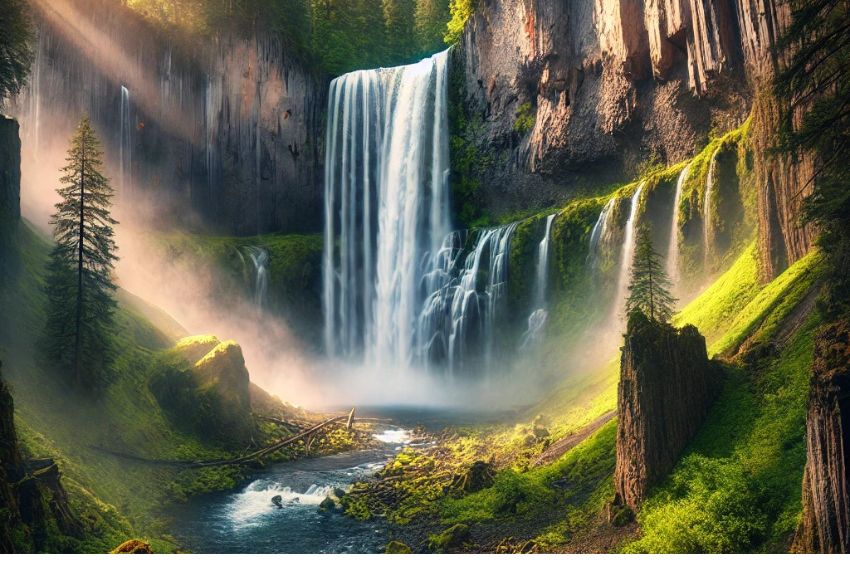How Are Waterfalls Formed? A Guide for GCSE Geography
Waterfalls are among the most captivating natural features in geography, formed by a unique set of geological processes over time. So, how are the waterfalls formed? This topic is central to GCSE Geography, helping students understand the powerful forces that shape landscapes. In this guide, we’ll break down how waterfalls form, the types of erosion involved, and the factors influencing their creation. So, dwell in and learn everything you want to know about waterfalls.
What Is a Waterfall?
A waterfall is a point in a river where water flows over a vertical drop or a series of steep drops, often cascading dramatically. Waterfalls usually form in the upper course of a river where the landscape is more rugged, and variations in rock type allow for such vertical changes in elevation.
What Is a Gorge?
A gorge is a narrow, steep-sided valley formed by river erosion, often downstream of a waterfall. Gorges are carved out over time as the waterfall retreats backward due to continuous erosion at the base of the fall. You can read a detailed information about gorges here.
How Are Waterfalls Formed? A Step-by-Step Guide

1. The Foundation: Formation of a Step in the Riverbed with Different Rock Layers
Waterfalls often begin where two types of rock meet: a layer of hard rock on top of a layer of softer rock. Over time, the river’s flow wears away the softer rock more easily than the harder layer above. This difference in erosion rates creates a small step in the riverbed. Imagine a river flowing over a landscape where tough, resistant rock, like granite or basalt, lies over something softer and more vulnerable, such as limestone or shale.
2. Erosion Begins: Forming the Drop
As the river flows over this step, the softer rock below is continuously worn away. Because the softer rock erodes faster than the hard rock above it, a more significant ledge begins to develop. This ledge creates the first signs of a drop, where water starts cascading down rather than flowing smoothly along a level bed.
3. Erosion Intensifies at the Base
Once a drop has formed, the waterfall is essentially born. As the water plunges down from the ledge, it hits the riverbed below with tremendous force. This impact, combined with the swirling action of rocks and sediment carried by the water, starts eroding the riverbed where the waterfall meets it. Over time, a plunge pool forms. This plunge pool continues to grow as water and rocks swirl around, digging even deeper.
What Is a Plunge Pool?
A plunge pool is a deep basin that forms at the base of a waterfall, carved out by the force of falling water and erosion. Over time, hydraulic action, corrasion, and corrosion intensify the depth and size of the plunge pool as rocks and sediment swirl around, eroding the riverbed.
4. The Overhang Forms and Collapses
As erosion carves out the plunge pool at the base, it also begins to undercut the hard rock layer above. This means that the hard rock ledge starts to jut out over the softer rock below, creating an overhang. However, as erosion continues to remove the softer rock below, this overhang eventually becomes unstable. When it can no longer support its own weight, it collapses, sending large pieces of rock tumbling into the plunge pool. This collapse adds even more material for the river to erode, making the plunge pool deeper and more dramatic.
5. The Waterfall Retreats Upstream
Every time the overhang collapses, the waterfall “moves” slightly upstream. This process of undercutting, collapse, and retreat continues over centuries or even millennia, causing the waterfall to slowly work its way backward along the riverbed. As the waterfall retreats, it leaves behind a narrow, steep-sided valley known as a gorge. This gorge is a permanent reminder of the waterfall’s original path.
Types of Erosion Shaping Waterfalls
The relentless erosion that forms waterfalls happens through several mechanisms, each contributing uniquely to the formation process:
- Hydraulic Action: This is the sheer force of water impacting the rock. When water crashes against rock surfaces, it can compress air into tiny cracks, gradually widening them and breaking off rock fragments. Hydraulic action is particularly effective at the plunge pool, where the water’s impact is strongest.
- Corrasion (Abrasion): Think of this as “sandpapering” the rock. Rocks and sediment carried by the river are flung against the riverbed and sides, scraping away at the rock surface. Over time, this process wears down the softer rock layers more quickly, helping to create the plunge pool and undercutting the waterfall’s base.
- Corrosion (Solution): Corrosion happens when water dissolves minerals in the rock, slowly wearing it away. This type of erosion is especially common in areas with limestone or other easily dissolved rocks. Though it’s a slower process, corrosion contributes to the gradual weakening of rock layers, making them more susceptible to other forms of erosion.
What Factors Contribute to Waterfall Formation?
Several factors determine whether a waterfall will form and how quickly it develops:
- Rock Composition: Waterfalls require a contrast between hard and soft rock layers. Hard rock forms the ledge, while softer rock below erodes to create the drop.
- River Flow and Speed: The amount of water flowing over a waterfall and its speed influence the rate of erosion. Fast-flowing rivers in rainy regions or rivers fed by melting snow tend to form waterfalls more quickly.
- Climate: In colder climates, freeze-thaw action can accelerate erosion, especially when water enters cracks in the rock, freezes, expands, and breaks the rock apart.
- Geological Activity: Earthquakes, tectonic shifts, or volcanic activity can change a river’s course or create sudden elevation changes, leading to the formation of waterfalls in areas where they may not otherwise occur.

How Long Does It Take for a Waterfall to Form?
The time required to form a waterfall varies dramatically. Small waterfalls can form within a few hundred years, especially in regions with high water flow and softer rock. Large, iconic waterfalls like Niagara Falls or Angel Falls have formed over thousands to millions of years, shaped by a continuous process of erosion and retreat. Geology, climate, and river characteristics all play a role in determining the speed of this formation.
Understanding the formation of waterfalls gives us insight into the powerful forces shaping the Earth’s landscapes. For GCSE Geography students, waterfalls illustrate the complex interactions between water, rock, and time, highlighting how seemingly small actions—like a river flowing over a rock—can create spectacular features through gradual but relentless processes.
How Are Waterfalls Classified?
Waterfalls are classified based on their appearance, structure, and the way water flows over them. Each type of waterfall has unique characteristics influenced by the landscape, water flow, and erosion processes. Here are the main classifications of waterfalls:
Plunge Waterfalls
Water falls vertically and does not touch the underlying rock as it descends. Plunge waterfalls are powerful and often form deep plunge pools below.
- Example: Bridalveil Fall in Yosemite National Park, USA.
Horsetail Waterfalls
Water maintains some contact with the rock as it descends, flowing down in a thin, elegant stream. Horsetail waterfalls spread out across the rock face, resembling a horse’s tail.
- Example: Reichenbach Falls in Switzerland.
Cataract Waterfalls
These are massive, powerful waterfalls with high volumes of water flowing over a large drop. Cataract waterfalls often produce a lot of mist and are very loud.
- Example: Victoria Falls on the border of Zambia and Zimbabwe.
Block Waterfalls
Water flows in a wide, continuous sheet over a large rock ledge or cliff. Block waterfalls can be broad and are characterised by a uniform, wide appearance.
- Example: Niagara Falls in North America.
Cascade Waterfalls
Water flows over a series of rock steps or terraces, creating a cascading effect. Cascade waterfalls tend to be less steep and are often scenic as water tumbles over multiple drops.
- Example: Virginia Falls in Canada.
Segmented Waterfalls
Water splits into separate flows as it descends, creating multiple smaller streams. Segmented waterfalls are divided by rocks or ledges, forming distinct channels within the fall.
- Example: Lech Falls in Germany.
Tiered or Multi-Step Waterfalls
These waterfalls have multiple steps or drops as the water flows downstream, creating a series of smaller waterfalls within the same formation.
- Example: Angel Falls in Venezuela, the world’s tallest waterfall, which flows over several drops.
Punchbowl Waterfalls
Water falls into a wide, circular basin, or “punchbowl,” at the base, usually forming a deep pool. The water flows in a narrow stream before widening at the bowl.
- Example: Punchbowl Falls in Oregon, USA.
Fan Waterfalls
Water spreads out horizontally as it descends, fanning out over a wide rock face. These waterfalls appear broad and may have a fan-like shape as water disperses.
- Example: Virgin Falls in Tennessee, USA.
Frozen Waterfalls
- Description: During winter, some waterfalls freeze, forming stunning ice formations that appear to “flow” downward in icy cascades. These waterfalls are temporarily frozen but can still exhibit characteristic shapes.
- Example: Various waterfalls in colder regions, like Bridal Veil Falls in Colorado, USA, often freeze during winter months.

Waterfall Classification Based on Height and Volume
In addition to their structural classifications, waterfalls are often categorised by their height and volume (the amount of water flowing over the falls). These classifications provide valuable information on the scale and power of different waterfalls and help us understand the geological impact of each type. Here’s a more detailed look:
Classification by Height
- Tall Waterfalls: We generally define tall waterfalls as those with a drop of over 100 meters (328 feet). Dramatic changes in elevation within mountainous or highland areas usually form these falls. Their considerable height gives tall waterfalls a visually striking impact, and they are often surrounded by steep cliffs or gorges. For example: Angel Falls in Venezuela, the world’s tallest waterfall, is 979 metres (3,212 feet). Also, Waterfalls over 300 metres (984 feet), such as Tugela Falls in South Africa, are exceptionally tall and rare.
- Moderate-Height Waterfalls: Falls within 30 to 100 metres (98 to 328 feet) are classified as moderate-height waterfalls. These are common in hilly or mountainous regions and still provide impressive scenic views. Sutherland Falls in New Zealand, at 580 metres (1,902 feet) in height, though tall, has steps that break up its descent, making it appear within the moderate-height category at certain stages.
- Short Waterfalls: Waterfalls under 30 metres (98 feet) are typically considered short. Though they lack height, they may still feature unique formations and can be powerful, especially with high water flow. Many local falls and cascades fall into this category, like Lumsdale Falls in the UK, which is around 10 metres (32 feet).
Classification by Volume (Flow Rate)
Volume, or flow rate, refers to the amount of water flowing over the waterfall, typically measured in cubic metres per second (m³/s). The volume of water affects the waterfall’s power and the force of its plunge pool.
- High-Volume Waterfalls: Waterfalls with a high flow rate are often referred to as cataract waterfalls. They have significant amounts of water plunging over the drop, creating powerful currents, loud sounds, and substantial mist. For example Niagara Falls on the Canada-USA border has an average flow rate of 2,400 m³/s. Also, Iguazu Falls in South America can reach flow rates over 6,000 m³/s during the rainy season.
- Moderate-Volume Waterfalls: These falls have a flow rate between 100 and 1,000 m³/s. They provide a balance of visual and audible impact without the overwhelming power of high-volume waterfalls. Victoria Falls in Africa has an average flow rate of around 1,088 m³/s, though it can vary seasonally.
- Low-Volume Waterfalls: Low-volume waterfalls have less than 100 m³/s. They tend to be smaller, quieter, and often found in regions with lower rainfall. Despite their lower flow rate, they can be visually stunning, particularly when surrounded by lush landscapes. Many waterfalls in drier regions fall into this category, such as Seljalandsfoss in Iceland, which has a relatively low but scenic flow rate.
Classification by Width
Another aspect to consider is the width of the waterfall, which can enhance its scenic appeal:
- Wide Waterfalls: Defined by a width of over 50 metres across, wide waterfalls create a “curtain” effect as water flows over a broad ledge. These waterfalls are often segmented or block types, appearing as wide, flat sheets. ExamVictoria Falls spans 1,708 metres (5,604 feet), one of the widest in the world. Khone Phapheng Falls in Laos, Asia’s widest waterfall, is over 10,000 metres (32,808 feet) wide.
- Narrow Waterfalls: Narrow waterfalls are usually less than 50 metres wide, with water channelling through a confined space, often resulting in more forceful, dramatic flows. Multnomah Falls in Oregon, USA, is around 3 metres (10 feet) wide but is visually striking due to its narrow, high drop.
Why Waterfall Classifications Matter
Waterfall classifications help geographers, scientists, and enthusiasts understand the diverse forms waterfalls take and the geological processes that shape them. For example:
- Tall waterfalls show the power of tectonic forces and steep gradient changes, often found in mountainous regions.
- High-volume waterfalls demonstrate the impact of water flow on erosion, carving deep plunge pools and shaping river paths.
- Wide waterfalls like Victoria Falls reveal how broad rock formations and rivers influence waterfall structures.
In GCSE Geography, understanding these types and classifications adds depth to studying the relationship between natural forces and landscapes. It highlights how water interacts with rock over time, creating unique natural features that vary in size, force, and appearance. Each waterfall offers a glimpse into the Earth’s dynamic processes, from powerful high-volume cascades to the delicate flows of narrow falls.
Conclusion
Some of the most awe-inspiring features in nature, waterfalls showcase unique shapes created by a combination of rock types, water flow, erosion, and geological forces. By understanding how are waterfalls formed or classified—whether by height, volume, or structure—students gain insight into the dynamic processes that shape our landscapes. From towering cascades formed over millions of years to broad, high-volume falls that dramatically alter their surroundings, waterfalls showcase the power and persistence of nature. For GCSE Geography students, exploring these classifications deepens their knowledge of physical geography and fosters appreciation for the complex interactions that create these natural wonders.
To support this learning, GCSE Geography tutors offer invaluable help, providing tailored guidance and deeper insights that enhance students’ understanding of geographical processes. With online tutoring, students can explore topics like waterfall formation more comprehensively, building a solid foundation in geography concepts that will support their academic growth and curiosity.
Similar topics:
Navigating Year 10: Setting Goals and Preparing for GCSEs
GCSE Geography Past Papers








